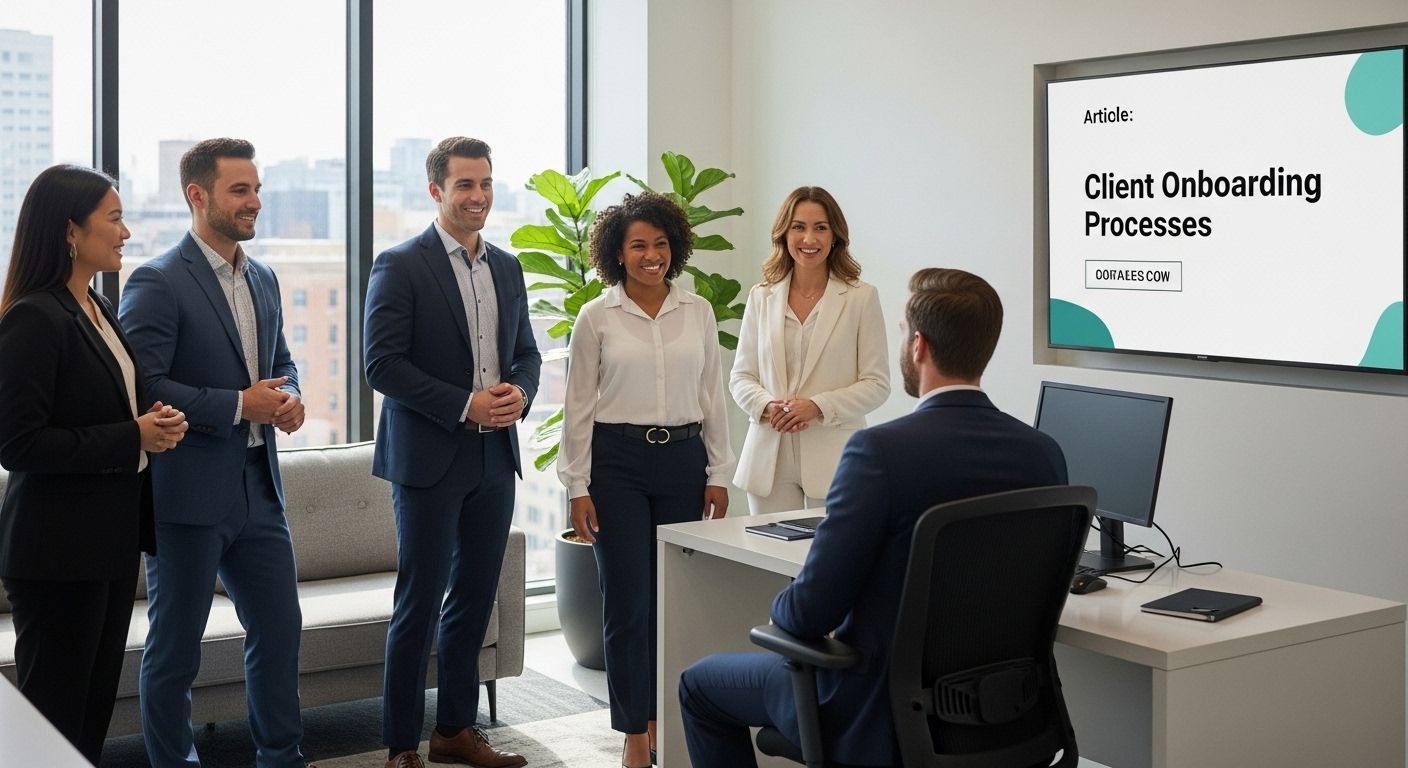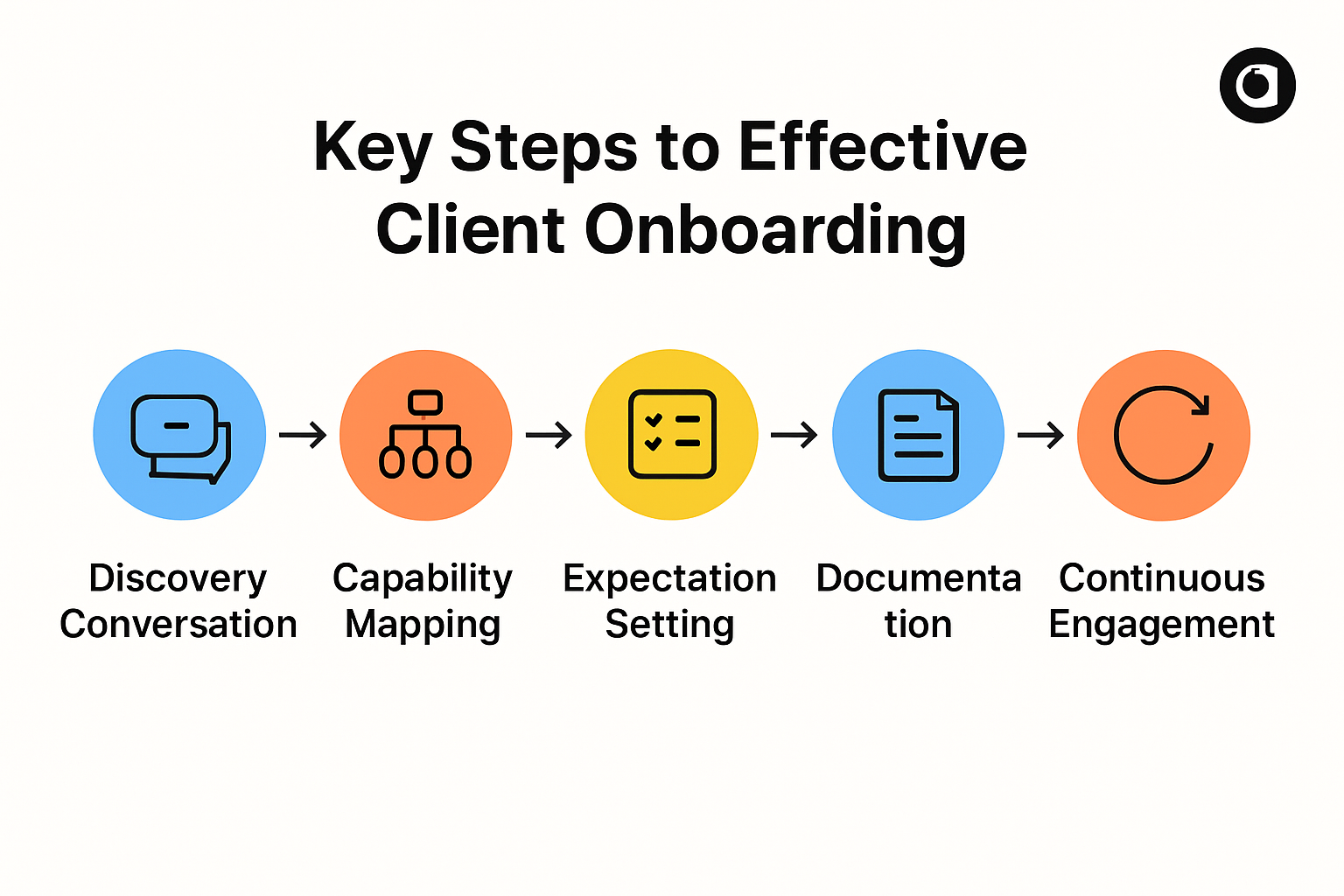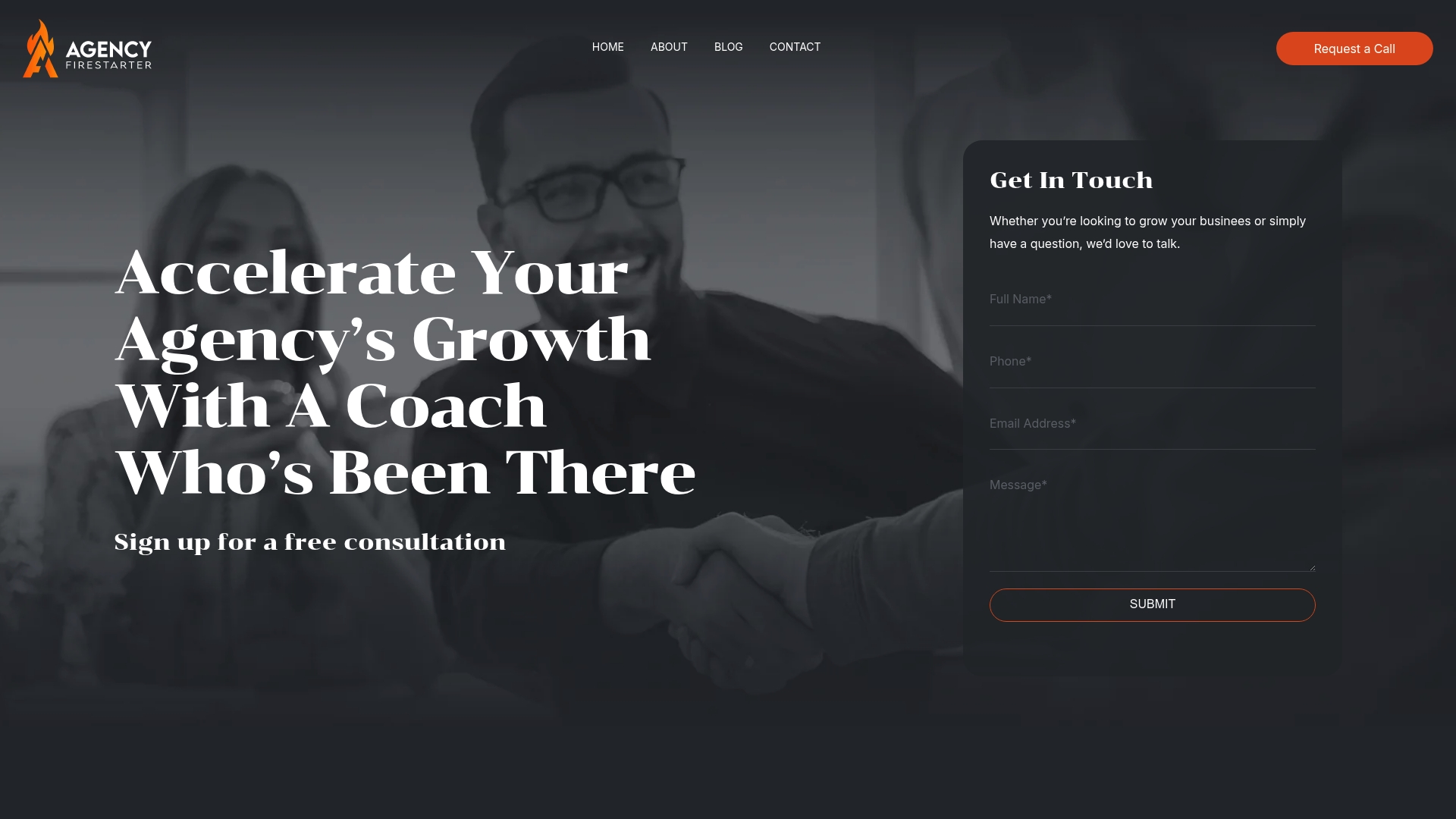
Client Onboarding Processes: Step-by-Step Success Guide
Client onboarding sounds simple enough. You set up a meeting, send a few emails, hand over some documents, and call it done. Yet, did you know that ineffective onboarding can directly lead to early client attrition, costing agencies thousands in lost contracts every year? Most businesses get caught up in paperwork when the real win comes from continuous engagement and personalization. There is a smarter way to create loyal clients from the very first interaction.
Table of Contents
- What Are Client Onboarding Processes?
- Key Steps To Effective Client Onboarding
- Best Practices For Digital Agencies And Consultants
- Common Challenges And How To Overcome Them
Quick Summary
| Takeaway | Explanation |
|---|---|
| Establish Clear Communication Channels | Clear channels set expectations and foster long-term collaboration from the outset. |
| Create Comprehensive Onboarding Documentation | Detailed materials guide clients and clarify roles, enhancing trust and transparency. |
| Engage Continuously Beyond Initial Setup | Ongoing support and feedback solidify relationships and ensure client satisfaction. |
| Personalize the Client Experience | Tailored approaches show commitment and address specific client needs effectively. |
| Anticipate and Address Common Challenges | Proactively solving potential issues enhances relationships and supports successful onboarding. |
What Are Client Onboarding Processes?
Client onboarding processes represent the strategic framework that transforms initial client interactions into lasting, productive relationships. These systematic approaches guide new clients from their first point of contact through initial engagement, ensuring a smooth transition and setting the foundation for long term collaboration.
Defining the Client Onboarding Journey
At its core, client onboarding is more than a simple welcome procedure. According to Old Dominion University’s organizational insights, onboarding is a comprehensive process that introduces new participants to an organization’s structure, mission, and core values. In the context of client relationships, this translates to a carefully designed pathway that helps clients understand your services, expectations, and the unique value you provide.
The primary objectives of client onboarding include establishing clear communication channels, aligning expectations, and creating a positive initial experience that builds trust and confidence. Effective onboarding goes beyond transactional interactions, focusing instead on creating meaningful connections that demonstrate your commitment to the client’s success.
Key Components of Client Onboarding
Successful client onboarding processes typically encompass several critical elements. The U.S. Department of the Interior’s onboarding framework highlights the importance of comprehensive integration, which can be adapted to client relationships.
- Initial Assessment: Thoroughly understanding the client’s specific needs, goals, and challenges
- Welcome Package: Providing clear documentation, communication protocols, and initial resources
- Strategic Alignment: Establishing mutual expectations and defining project or service parameters
- Communication Framework: Setting up regular check ins, reporting mechanisms, and feedback channels
Creating a Seamless Client Experience
The ultimate goal of client onboarding is to create a smooth, transparent, and engaging introduction to your services. As the State of Oregon’s organizational guidance suggests, an effective onboarding process enables quick integration and meaningful contribution. For service providers, this means designing a process that immediately demonstrates your professionalism, expertise, and commitment to client success.
By implementing a robust client onboarding process, businesses can significantly reduce potential misunderstandings, accelerate project initiation, and lay the groundwork for long term client satisfaction. The process serves as a critical first impression that can differentiate your services in a competitive marketplace, transforming initial interactions into enduring, mutually beneficial partnerships.
Remember that client onboarding is not a one size fits all approach. Each client will have unique requirements, and your process should be flexible enough to accommodate individual needs while maintaining a consistent, high quality framework of engagement.
Key Steps to Effective Client Onboarding
Designing a robust client onboarding process requires strategic planning and meticulous execution. While each organization will have unique nuances, several universal steps can transform initial client interactions into powerful, productive relationships.
Initial Engagement and Needs Assessment
The first critical phase of client onboarding centers on comprehensive needs assessment. According to research published in the National Institutes of Health, establishing clear communication channels early sets the foundation for successful long term collaboration. During this initial stage, agencies should focus on:
- Discovery Conversation: Conduct an in depth interview to understand client goals, challenges, and expectations
- Capability Mapping: Align your agency’s capabilities with the client’s specific requirements
- Expectation Setting: Clearly communicate potential outcomes, timelines, and potential limitations
Structured Onboarding Documentation
Documentation serves as the roadmap for client relationships. Comprehensive onboarding materials should provide clarity, build confidence, and establish professional boundaries. Key components include:
- Welcome packet with service descriptions
- Detailed project scope and deliverables
- Communication protocols
- Billing and payment expectations
- Confidentiality and legal agreements
Continuous Engagement and Support
Onboarding does not conclude after initial paperwork. Continuous engagement determines long term client satisfaction. Learn more about developing strong client relationships through strategic follow up and proactive communication.
Implement regular check ins, progress reports, and feedback mechanisms. These touchpoints demonstrate your commitment to client success and allow for real time adjustments. Successful agencies recognize that onboarding is an ongoing process of relationship building, not a one time transaction.
By methodically executing these key steps, agencies can create a client onboarding process that not only meets but exceeds client expectations. The goal is to transform initial interactions into enduring partnerships characterized by trust, transparency, and mutual growth.
To help visualize the key steps outlined in building an effective client onboarding process, the table below summarizes each phase and its critical activities.
| Step | Description | Key Activities |
|---|---|---|
| Initial Engagement & Needs Assessment | Establish rapport, understand client objectives, align capabilities | Discovery conversation, capability mapping, expectation setting |
| Structured Onboarding Documentation | Provide clear informational resources and agreements | Welcome packet, project scope, communication protocols, billing details |
| Continuous Engagement & Support | Maintain client relationship through regular interactions and value delivery | Regular check-ins, progress reports, feedback mechanisms |

Remember that flexibility remains crucial. While these steps provide a solid framework, each client relationship will require subtle customization to truly resonate and deliver exceptional value.
Best Practices for Digital Agencies and Consultants
Digital agencies and consultants must develop sophisticated client onboarding strategies that go beyond traditional transactional approaches. These best practices create a foundation for building long lasting, mutually beneficial client relationships.
Structured Onboarding Framework
According to the Promotional Products Association International, a robust onboarding process involves five critical steps that digital agencies can adapt to their unique contexts. Strategic onboarding requires a systematic approach that transforms initial interactions into lasting partnerships.
- Welcome Communication: Send comprehensive welcome materials that outline your agency’s value proposition
- Initial Discovery Meeting: Host an in depth consultation to understand client objectives
- Resource Introduction: Provide clear documentation about services, processes, and potential outcomes
- Milestone Definition: Establish clear, measurable goals and checkpoints
- Consistent Follow up: Maintain regular communication and progress tracking
Personalization and Expectation Management
Research highlights six critical best practices that digital agencies should incorporate into their client engagement strategies. These practices focus on creating tailored experiences that demonstrate genuine commitment to client success.
Key personalization strategies include:
- Developing custom communication approaches
- Creating role specific engagement plans
- Providing targeted educational resources
- Implementing flexible service adaptations
Continuous Improvement and Feedback
Effective client onboarding is an evolving process. Explore strategies for operational excellence that can transform your client engagement approach. A case study from academic research emphasizes the importance of structured integration processes that facilitate seamless collaboration.
Digital agencies should implement:
- Regular feedback collection mechanisms
- Periodic performance reviews
- Adaptive process improvement strategies
- Transparent communication channels
The most successful digital agencies recognize that client onboarding is not a one time event but an ongoing relationship building process. By implementing these best practices, agencies can differentiate themselves in a competitive marketplace, demonstrating professionalism, expertise, and a genuine commitment to client success.
Remember that while these practices provide a solid framework, each client relationship requires nuanced understanding and flexibility. The goal is to create an onboarding experience that feels personalized, supportive, and aligned with the client’s unique business objectives.
Common Challenges and How to Overcome Them
Client onboarding processes are complex journeys filled with potential obstacles that can derail successful client relationships. Understanding these challenges and developing strategic solutions is crucial for digital agencies and consultants seeking to create seamless, productive client experiences.
Communication and Expectation Misalignment
Research from remote work studies highlights that communication barriers can significantly impede effective onboarding. Potential communication challenges include:
- Unclear role definitions
- Misunderstood project scope
- Inconsistent communication channels
- Cultural or professional communication differences
To mitigate these risks, agencies must:
- Develop comprehensive communication protocols
- Create detailed project documentation
- Establish regular check in schedules
- Use multiple communication platforms
Technical Integration and Process Complexity
Technical challenges often emerge during client onboarding, particularly in digital environments. A systematic review of professional training emphasizes the importance of structured, supported integration processes.
Key technical onboarding challenges include:
- Software and tool compatibility
- Data migration complexities
- Access management and security protocols
- Training and knowledge transfer
Learn more about navigating operational complexities to ensure smooth client transitions and minimize potential disruptions.
Retention and Long Term Engagement
Research indicates that ineffective onboarding can lead to client attrition. Successful agencies must view onboarding as an ongoing process of relationship building and continuous value demonstration.
Strategies for maintaining client engagement:
- Proactive problem solving
- Regular performance reviews
- Adaptive service offerings
- Personalized client success plans
Effective challenge management requires a holistic approach that anticipates potential issues, creates flexible response mechanisms, and maintains a client centric perspective. Digital agencies must continuously evolve their onboarding processes, treating each challenge as an opportunity to demonstrate professionalism, expertise, and commitment.
The following table concisely summarizes common challenges encountered during client onboarding, with their examples and recommended solutions as described in the article.
| Challenge Type | Examples | Solutions/Strategies |
|---|---|---|
| Communication & Expectation Misalignment | Unclear roles, misunderstood scope, inconsistent channels | Communication protocols, documentation, regular check-ins |
| Technical Integration & Process Complexity | Software compatibility, data migration, access management | Supported integration, training, operational best practices |
| Retention & Long-Term Engagement | Client attrition, disengagement | Proactive problem solving, performance reviews, adaptive services |
Remember that no onboarding process is perfect. The key is to remain adaptable, responsive, and focused on creating genuine value for your clients. By developing robust strategies to address common challenges, agencies can transform potential obstacles into opportunities for strengthening client relationships.

Frequently Asked Questions
What is the purpose of client onboarding processes?
Client onboarding processes are designed to transform initial client interactions into productive, long-lasting relationships by establishing clear communication, aligning expectations, and creating a positive initial experience.
What key components should be included in effective client onboarding?
Effective client onboarding should include an initial assessment, a welcome package, strategic alignment, and a well-defined communication framework to guide the client through the onboarding journey.
How can continuous engagement improve client onboarding?
Continuous engagement improves client onboarding by maintaining regular communication, providing ongoing support, and facilitating real-time adjustments that enhance client satisfaction and foster long-term relationships.
What are common challenges faced during the client onboarding process?
Common challenges include communication and expectation misalignment, technical integration issues, and difficulties in retaining clients over the long term. Addressing these challenges proactively is crucial for effective onboarding.
Transform Your Client Onboarding Into a Growth Engine
If you are tired of seeing clients disengage after onboarding or struggle with unclear communication and retention, this article highlights a common setback for agency owners. Inconsistent onboarding processes can block growth and eat away at your profits. Effective client onboarding, as detailed above, is not just about paperwork. It is about building real trust, setting the right expectations, and creating a seamless experience that drives long-term loyalty. But without a proven framework or expert guidance, even experienced agencies risk missing out on new opportunities for scalable success.

Bring every client into your agency with total confidence. At Agency Firestarter, we deliver hands-on marketing and business coaching tailored to digital agencies and consultants who want to improve onboarding, grow revenue, and create scalable systems. Explore our business growth coaching solutions that help you implement winning onboarding strategies from day one. Do not let outdated processes hold you back. Start your journey to smoother client relationships and stronger results with a free consultation today.
Recommended
- Agency Business Development: Proven Strategies for Growth – Business Coach For Digital Marketing Companies, SEO, Social Media Agencies
- Digital Marketing Business Coach For Digital Marketing Agencies, SEO, Social Media
- Coaching Versus Mentoring: Key Differences for Agencies – Business Coach For Digital Marketing Companies, SEO, Social Media Agencies
- What Is Operational Excellence? 2025 Guide for Agencies – Business Coach For Digital Marketing Companies, SEO, Social Media Agencies
